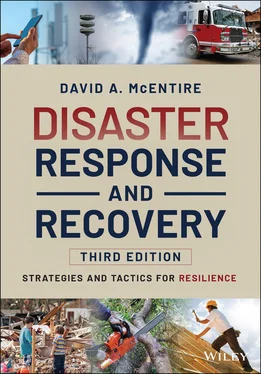David A. McEntire - Disaster Response and Recovery
Здесь есть возможность читать онлайн «David A. McEntire - Disaster Response and Recovery» — ознакомительный отрывок электронной книги совершенно бесплатно, а после прочтения отрывка купить полную версию. В некоторых случаях можно слушать аудио, скачать через торрент в формате fb2 и присутствует краткое содержание. Жанр: unrecognised, на английском языке. Описание произведения, (предисловие) а так же отзывы посетителей доступны на портале библиотеки ЛибКат.
- Название:Disaster Response and Recovery
- Автор:
- Жанр:
- Год:неизвестен
- ISBN:нет данных
- Рейтинг книги:5 / 5. Голосов: 1
-
Избранное:Добавить в избранное
- Отзывы:
-
Ваша оценка:
- 100
- 1
- 2
- 3
- 4
- 5
Disaster Response and Recovery: краткое содержание, описание и аннотация
Предлагаем к чтению аннотацию, описание, краткое содержание или предисловие (зависит от того, что написал сам автор книги «Disaster Response and Recovery»). Если вы не нашли необходимую информацию о книге — напишите в комментариях, мы постараемся отыскать её.
The new edition of the standard textbook in the field, updated with new studies and practical guidelines for reacting to the complexities of today’s disasters Disaster Response and Recovery: Strategies and Tactics for Resilience
Disaster Response and Recovery: Strategies and Tactics for Resilience, Third Edition
Disaster Response and Recovery — читать онлайн ознакомительный отрывок
Ниже представлен текст книги, разбитый по страницам. Система сохранения места последней прочитанной страницы, позволяет с удобством читать онлайн бесплатно книгу «Disaster Response and Recovery», без необходимости каждый раз заново искать на чём Вы остановились. Поставьте закладку, и сможете в любой момент перейти на страницу, на которой закончили чтение.
Интервал:
Закладка:
The 9/11 terrorist attacks caused the United States to intervene in Iraq to depose Saddam Hussein. It also pushed back the Taliban in Afghanistan. While these conflicts were protracted, there is a potential for even greater conflict in the Middle East due to ongoing tensions between Israel and its enemies (particularly Iran). And, there is also fear the United States will experience inter‐state conflicts with North Korea, China and Russia in the future. Tensions have been mounting and it is unknown if and when something might trigger hostilities.
Self‐Check
What is a civil/conflict hazard?
What are the types of civil/conflict hazards?
What is the role of humans in civil/conflict hazards?
How is each type of civil/conflict hazard related to the other? Are they different? If so, how?
1.5 The Complexity of Disasters
Although it is useful to classify hazards in order to understand their unique features, it is important for you to recognize that hazards are not mutually exclusive. In other words, each hazard may interact with others in convoluted and perhaps even unpredictable ways. The examples are numerous:
An earthquake may break a dam, cause a building collapse, and produce landslides. It may also a Natech disaster which results from a combination of natural and technological hazards).
Degradation of the environment (e.g., deforestation) could exacerbate flash flooding and create mudslides that are typically only related to severe storms.
Flooding could lead to the spread of certain communicable diseases.
A train derailment could result in the spill of dangerous chemicals and harm the natural habitat and pose danger to nearby populations.
Those participating in mass shooting and riots may trigger panic flight behavior.
Terrorism may have a significant negative impact on critical infrastructure, public health and psychological well‐being.
These are not hypothetical situations. Compound disasters occur more frequently than people think. For instance, on February 7, 2021, a glacier broke off a Himalayan mountain near Uttarakhand in Northern India. The massive displacement of ice, rock, and water broke a dam and flooded the Rishiganga, Dhauliganga and Alaknada Rivers. The water rushed downstream and subsequently damaged two other hydroelectric projects, as well as a number of roads and bridges. Several villages were impacted, and at least 36 people died and more than 200 were categorized as missing.
In addition, human vulnerability will complicate and exacerbate the impact of hazards/triggering agents. Studies reveal that disasters are not caused by a “single factor;” instead they are often the result of “accumulation of complex chains” of actions and events (Aini 2005, 56). For instance, warnings may not be heeded due to language barriers or cultural misunderstandings. Poverty may limit people’s options for evacuation and sheltering. A lack of preparedness may complicate emergency actions to save lives and treat the injured. Health disparities may exacerbate the spread of disease among vulnerable populations. Insufficient training may slow down damage assessment activities. Conflict over recovery policies may halt rebuilding efforts for an extended period of time. The diverse ways vulnerability interacts with hazards are almost limitless. The complexity of disasters is not always understood or appreciated.
The major point to consider from this section is that a single hazard is not the only thing you need to be concerned about as an emergency manager. You must appreciate the complex interaction of multiple hazards and diverse vulnerabilities as these relationships can have serious impacts upon response and recovery operations. In most cases, you will be responding to multiple hazards and vulnerabilities in any given disaster. This creates serious challenges that you must be ready to deal with at a moment’s notice.
For Example
Hurricane Katrina was a Complex Disaster
Hurricane Katrina will long be remembered as a complex disaster. In September 2005, Hurricane Katrina—a category four storm—slammed into the coastal areas of Louisiana, Mississippi, and Alabama. Each of these states suffered severe losses. However, it was New Orleans that gained national and international attention. The winds of the hurricane damaged structures in the “Big Easy” and affected power and phone service. Nevertheless, it was the storm surge and heavy rains that were most problematic. Lake Pontchartrain rose to historic levels and the levees set up to keep the waters from inundating the below‐sea‐level community were breached. New Orleans was flooded. Water, sewer, and gas lines were broken. The contents of numerous petroleum and hazardous chemical tanks were released. Homes and businesses were under water. Making matters worse, some antisocial behaviors including looting and violent conflict were reported around the city. The local, state, and federal response was slow and inadequate. The reaction was also hampered further when criminals began firing weapons at rescue helicopters and relief workers. Many evacuees sought shelter in the superdome where supplies were inadequate, and conditions quickly became filthy. Disaster victims were becoming increasingly concerned about the conditions prior to the arrival of federal aid arrived at the superdome. The delivery of assistance was delayed because flooding severely affected the transportation system. Public health workers feared an outbreak of disease due to the squalid living conditions and requested an evacuation of the city. However, the required exodus was complicated by poor planning before the hurricane and insufficient communication during response and recovery operations ( Figure 1‐8). Katrina therefore involved natural, environmental, biological, technological, and civil hazards. And, the consequences are Hurricane Katrina are still being felt to this day.
1.5.1 The Impact of Disasters
As mentioned earlier, when a hazard or multiple hazards interact with humans and the vulnerability they create, disasters occur. The consequences may be staggering. People may be injured or killed as a result of these destructive events, and the impact is often significant. From 2001 to 2012, natural disasters killed 1.9 million people worldwide and affected another 2.9 billion (UNISDR, 2013). Deaths have also been significant in the United States. For instance, an admittedly dated study “estimated that natural hazards killed over 24,000 people between January 1, 1975 and December 31, 1994” (Mileti, 1999, p. 66). These statistics were collected from fires, flooding or other hazards, and these numbers do not include the toll of disease outbreaks, which are also substantial. The number of injuries from disasters should not be overlooked either, as it averages about 100 per week in the United States (Mileti, 1999, p. 66). Such injuries may include superficial cuts from flying glass in a tornado or serious internal wounds due to the collapse of a building after an earthquake.
Property is likewise damaged or destroyed in disasters, costing billions of dollars each year. Homes and belongings are decimated by landslides, fishing vessels are sunk in hurricanes, and businesses are flattened by strong winds. Furniture, clothing, televisions and cars are ruined in disasters. Losses average about $1 billion per week in the United States, and these figures are rising exponentially each decade (Mileti, 1999, p. 66). Hazardous materials spills, nuclear accidents, and other events can likewise degrade the natural environment, thereby affecting the health and well‐being of people beyond the current generation.
Disasters also disrupt individuals and society as a whole. Routine activities such as cooking, sleeping, and bathing may be hindered due to the damages of one’s appliances, bed, or home. Jobs are also lost, business transactions are prohibited, and traffic is snarled when hazards impact corporations and transportation systems. Disasters are also accompanied by building collapses, road closures, and downed power and phone lines. The infrastructure is often severely impacted. Simple tasks such as mailing a letter or having your trash hauled away cannot be performed because the government is also adversely affected by the event(s). Disasters, including terrorist attacks, cause economic decline and can sometimes jeopardize mental health. Disasters of all types have even led to political turmoil at times and have changed the direction of policy in the United States (e.g., the creation of the Department of Homeland Security after 9/11). There is no doubt that disasters have a bearing upon taxes, insurance rates, and many other aspects of our lives.
Читать дальшеИнтервал:
Закладка:
Похожие книги на «Disaster Response and Recovery»
Представляем Вашему вниманию похожие книги на «Disaster Response and Recovery» списком для выбора. Мы отобрали схожую по названию и смыслу литературу в надежде предоставить читателям больше вариантов отыскать новые, интересные, ещё непрочитанные произведения.
Обсуждение, отзывы о книге «Disaster Response and Recovery» и просто собственные мнения читателей. Оставьте ваши комментарии, напишите, что Вы думаете о произведении, его смысле или главных героях. Укажите что конкретно понравилось, а что нет, и почему Вы так считаете.












